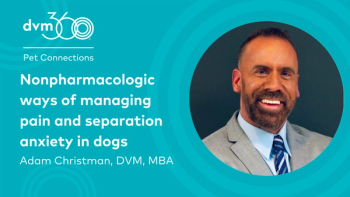
Relationships: They're what it's all about
Relationships fascinate me. They contribute much to the satisfaction and happiness we derive from life. They are also the source of much pain and sadness.
Relationships fascinate me.
They contribute much to the satisfaction and happiness we derive fromlife. They are also the source of much pain and sadness.
Whether between husband and wife, parent and child, colleagues, friends,siblings or clients, our interactions with other people bear a huge impacton how we see ourselves. Our self-esteem can rise or fall precipitouslywhen a significant person shares either a compliment or a criticism.
Two levels
As a practitioner, I had two levels of professional relationships; onewas with the other doctors in the two practices with which I worked. Theother was with the many dairy producers I served, particularly those onmy monthly "herd check" schedule.
When I left practice, my colleagues at the Willow Creek Animal Hospitalorganized a surprise party in my honor. I was deeply touched by it, buteven more so by a gift that they orchestrated. Forty-four of the 45 farmson my schedule contributed a "patch", with the name of their farm.Most were hand done, and all are unique. Later, they were combined intoa quilt, which is on display in our home.
The quilt is very special to me, because it symbolizes the relationshipsI had with those people. When I look at it, I can picture their faces andrecall experiences at their farms.
Some of those experiences were very positive, and I left the farm withfeelings of elation and success. Other times, I left with doubts and depression.All of the experiences became a part of the background that defined whoI was as a dairy practitioner.
Everyone has a story
One of the patches is from Claude and Emma Brown and their children.Their farm was one of the first on my schedule when I joined Willow Creekin 1987. At that time they were in their early 30s, and milking 38 cowsin a rented barn.
Their herd average was 13,000 pounds of milk, and their somatic cellcount more than 500,000. Cows were somewhat small and rather thin. Cashflow was a real problem.
Despite these challenges, the Browns were always upbeat and positive.They readily accepted my suggestion that part of each visit be devoted toreviewing herd performance and planning ways to improve it.
They did this knowing that their monthly veterinary bill would be $30or so a month higher because we prolonged the visit in this manner (quadrantII time for you Steven Covey followers).
Progress for the Browns came slowly, with ebbs and flows, but it didcome.
I was always impressed with their willingness to pay for advice and tomake changes. I remember spending two hours evaluating milking equipmentand techniques and feeling guilty when I handed them the bill. But theyfollowed suggestions and two years later, received quality premiums forquality milk.
They listened
In the early '90s, a farm two miles away came up for sale, and Claudeand Emma somehow convinced a bank to lend them money to buy it.
This barn on this farm was no bigger, but it had better stall designand ventilation. By then their production had risen into the 20,000-poundrange.
While the adult cow barn was well designed and in good repair, facilitiesfor young stock was a different matter. Within the first six months severalremodeling projects had been completed.
I recall vaccinating calves in a converted machinery shed, and suggestingthat health and growth would be better if the ridge was opened up.
Claude listened attentively, but did not say much. I interpreted hissilence as skepticism, and resigned myself to discussing the subject againwhen we treated the pneumonia that was sure to come.
The next month, when we approached the same building, I saw the modifiedroof and stopped to evaluate it. Claude had followed my suggestions completely.I was somewhat astonished and expressed that sentiment to him.
"Well, you said we should do it if we wanted healthy calves, andwe want healthy calves."
It was that simple.
Throughout the '90s, progress continued for the Browns. An addition wasmade to the tie stall barn, tunnel ventilation and mattresses were installed,more modifications and additions were performed on outbuildings. A smalladjoining farm was purchased. And each month, when the animal work was completed,we went to the house and sat at the kitchen table to review the recordsand make plans.
I shared their satisfaction as production rose to more than 26,000 pounds.
When I added financial consultation to my list of services, they sharedthose records with me as well. I was impressed with how much profit couldbe wrung from 50 cows when a combination of high production and carefulcost control was employed.
Last fall, a year after leaving practice, I was scheduled to speak ata meeting devoted to financial management of family dairy farms. As I waschecking my notes and getting ready, I saw Claude and Emma sitting in thegroup. My delight at seeing them was obvious as we exchanged greetings.
Satisfaction in practice
There are many components to attaining satisfaction from practice.
Those of you who read this column know that I place a lot of emphasison financial reward. In many ways, my level of income was a measuring stickof the value I provided my clients. If they would pay above-average fees,then they must, in turn, judge me to be above average. Yet, I am keenlyaware that factors other than income are important as well.
My relationship with the Browns and many other farm families demonstratedseveral things that I believe are relevant for dairy practitioners.
First, smaller farms are often excellent candidates for production medicineprograms. They will pay for them.
Second, along with financial compensation can come the satisfaction ofseeing your combined effort result in progress. Finally, you just mightget a quilt with 44 patches on it when the time comes to move to a differentstage in your career. And it doesn't get any better than that.
Newsletter
From exam room tips to practice management insights, get trusted veterinary news delivered straight to your inbox—subscribe to dvm360.




